E hika! The Sky has fallen. I realise that I end up writing a lot about tangi. Its appropriate to take a little time out in this, Te Wiki i Te Reo Maori, to explore this facet of Maori society. The fact of the matter is that if you live in a Maori environment all ceremonial starts with paying respect to the recently dead. (These columns called Nga Kupu Aroha are definitional ceremony). I mention this by way of explanation rather than apology. So I want to reflect on two mates, two deaths, and then I’ll move on to te hunga ora, the realm of the living. There you go, even at 54 I’m still struggling with my Pakeha positivist instincts to express the world in a binary fashion whereas, as I’m learning, English fails me when it comes to expressing the ‘and/ both’ duality of Maori life – my ancestor is ‘beside me’ rather than ‘above me’ as in the European view of the hereafter.
To some going to tangi is seen as an expensive indulgence, wallowing in grief and wasting otherwise productive time. And a critical perspective isn’t the preserve of some redneck whiteman. Sonny Lakatani, one-time Premier of Niue once told me he was bemused by the Maori focus on death. To me it seems that the ritual of Tangihanga becomes the change management process of a Maori community. The death creates a discontinuity and change to the status quo is essential. It might be a required change in behaviour. It might be a change in authority lines and community structure. It might be a tangi that leads to healing and coming together. Equally it might be a time that results in necessary conflict and division so as to challenge self defeating behaviours and break negative cycles . Whatever, the three or so days of living with each other, side by side, alongside the deceased, confronts all participants with both what has been in the past and what must be in the future.
So, e nga mate, ko koe te hoa toa e Mick, raua ko koe te rangatira e Rangi, haere ra e korua. Mick was one of the Wellington brothers, a fiery warrior type who at times claimed Cherokee whakapapa. Whatever, essentially he was an Aussie biker who had been part of some heavy event, was wanted by the Aussie cops, slipped into Aotearoa and hooked up with the Black Power. He then became connected with a sister of one of the brothers had three kids and so forth. Mick did some time in jail and had his ups and downs, but he was a good man at heart and a brave man to have by your side in times of trouble. His system was ravaged by years of substance abuse and hard living. He was 44 or years of age, young I suppose, in the mainstream society but a senior in ours where the consequences of lifestyle are harsh and often terminal. We buried him on a typically wet and windy Wellington day. A hangi was set at the back of the house and it steamed furiously as the rain poured down the slope and encountered the hot stones. After a short ceremony in the lounge where a Christian friend from the Prison Fellowship offered prayers and a hymn the boys gave poroporoaki and haka. We drove in a convoy led by the painter’s van that carried his body through the streets of Wellington. Brother Honk (you guessed it, another white boy!) led us to the back of the funeral home – no frills here folks – and, after one final haka ‘Ka hinga au Aue ka mate au!’ Mick was wheeled in to be incinerated. Moe mai e brother.

On Sunday Rangi Tareha came home to us at Waiohiki from Sydney in a 7ft. box. We waited for him at the gates of his whanau home to start the process whereby he would be returned to the arms of Papatuanuku. Sky, as he is known, was my brother-in-law. He was a very tall man, noble of bearing and manner, with a deep velvet bass voice and a laugh that gathered people. He’d spent the last thirty or so years in Sydney although he’d be back here for regular visits and whanau and golfing occasions. We’d encouraged him often to come home for his final years, especially after his first heart attack and the fitting of a pacemaker, but he reckoned the Aussie system treats Maori better than the system at home and he would increase the odds of living longer than his mum and dad by staying in the West Island. Looking at the stats you’d have to concede the argument. So he stayed, and at 63 years of age proved his point by living longer than both of his parents and outliving three of his younger siblings who, like many of their ilk, never got to see the fruits of superannuation. In Redfern Sydney about 500 people gathered to see him off. Rangi Francis Tareha was baptised a Catholic, became a Ratana, and determined that his Australian funeral service would be held in an Anglican Church – balancing the odds in the thereafter with the perfect send-off trifecta I reckon.
At home the big guy’s death had cranked us into gear, repairing and preparing and getting jobs done we should have done yonks ago. With the Waiohiki Marae having been burned down some five years ago in an unexplained fire, and the Marae Trustees still being unable to agree on a re-building programme to replace the facilities, we had to fall back on marquees and lean to’s rigged off sheds at the family homestead. The weather was crap but we were able to host waves of people, about 150 at a time, keep them warm and feed them well with wild pork, venison, and the Mad Butcher’s best cuts. There’s something magical when the whanau network swings into action. Stuff just comes together and its fun. Sir Norman Perry used to refer to it as ‘Maori rhythm’ and I never cease to be amazed with the sheer ingenuity that flows from this high synergy. On the final night after church service where the Hamuera Morehu Silver Band band played and the choir sang myriad-part hymns Hoani led the people of the kainga in a series of songs; songs that come from Waiohiki, songs that recount the history and people and bring to life memories both distant and recent. Sky would have been well pleased. We will miss him dearly but he is in peace. Haere atu ra te rangatira. This is the sacred and ancestral saying of the family: Kua mate Tareha, kei te uri ki te ora.
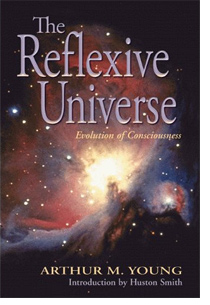 Years ago I read Arthur Young’s “The Reflexive Universe” and his explanation of the seven stages of evolution as a Theory of Process. Beyond his complex model of stages and levels my enduring memory is of a model explaining the point of change. I’d describe it as a line beginning on a circular trajectory but, where it enters the fourth quadrant it deviates into a wider arc and thus a new circle. Young contended that this break with expectation is at the point of disobedience, where the given law is confronted and denied. Change happens on the edge, the edge of thinking and the brink of disobedience and we are edge dwellers some of whom dare to think differently. This is why I think that we New Zealanders celebrate and fete alternative thinkers and disobedient persons such as Nelson Mandela and Angela Davis. Davis has been in Aotearoa proposing a radical agenda – that we abandon our current drive to criminalise and imprison our young brown citizens and instead commit ourselves to ‘decacerate’ and pursue restorative processes – and her lectures and meetings were all over subscribed.
Years ago I read Arthur Young’s “The Reflexive Universe” and his explanation of the seven stages of evolution as a Theory of Process. Beyond his complex model of stages and levels my enduring memory is of a model explaining the point of change. I’d describe it as a line beginning on a circular trajectory but, where it enters the fourth quadrant it deviates into a wider arc and thus a new circle. Young contended that this break with expectation is at the point of disobedience, where the given law is confronted and denied. Change happens on the edge, the edge of thinking and the brink of disobedience and we are edge dwellers some of whom dare to think differently. This is why I think that we New Zealanders celebrate and fete alternative thinkers and disobedient persons such as Nelson Mandela and Angela Davis. Davis has been in Aotearoa proposing a radical agenda – that we abandon our current drive to criminalise and imprison our young brown citizens and instead commit ourselves to ‘decacerate’ and pursue restorative processes – and her lectures and meetings were all over subscribed.
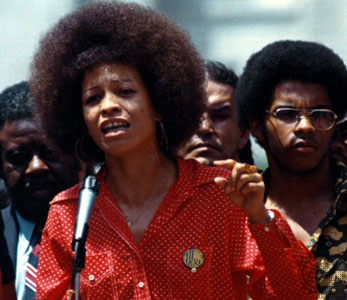
Angela Davis, 1974
It must be a beautiful feeling to fly halfway round the world, touch down in a seemingly contented society, and discover a body of people who have been enacting your disobedient thinking for over thirty years. My bro Will Ilolahia, one of the founders of the Polynesian Panthers, was able to tell Angela about how in the 1970’s he and his crew had followed her models of establishing pre-school breakfasts, homework centres and legal aid centres and the like. She had provided the intellectual grist for the mill of social activism in inner-city Auckland, the capital of Nesia. And, at the Auckland University Marae, veteran activist Syd Jackson spoke in similar form, commending her for keeping alight the candle of social resistance. Her smile said it all. “I’d be mortified” she said “if all that people remembered me for was my hair”.
Just as the korero of Angela Davis and Bobby Searle had motivated the likes of Polynesian Panthers Tigilau Ness and Will Ilolahia in Auckland in early 1970’s, the same agendas she promoted alongside those of other disobedients like James K Baxter were being picked up in Wellington by a crew of us in the Black Power with early work co-operatives like the Te Kaha Trust. The call of the moment is for us to return to that thinking and doing.
Reviewing the situation in Whanganui and working to settle things down in other hot spots around the country has had some of us discussing the various cycles that the Black Power had been through. In the early days of the BP (1970’s) just about everyone worked. Crime tended to be of the petty variety although drinking booze fed some disturbing crimes of violence. The structural unemployment of the 1980’s led to alternative but illegal income generating activity and the rise of the tinny-houses and what has been described as ‘organised crime’.
We need to have care in our use of language. This ‘organised crime’ is not the same level of stuff, not on the same plane, as international and truly organised crime. In my view what I am talking about is in the main what the Catholic Church would call venial sin as opposed to mortal sin. The type of organised crime we sometimes end up dealing with is often so damned petty. For instance there was a three day High Court trial here in Napier a week or so back in which two of the defendants – both brown beneficiaries – have been convicted of a conspiracy over the sale of 14 grams of cannabis – about equivalent to six teabags – and now face up to two years in jail! Scaled down it has all the echoes of the Weapons of Mass Destruction hype that became one justification of that disastrous war in Iraq. It fails me to understand how our policy makers can be truly perspicacious when it comes to international affairs but can’t see the wood for the trees at home.
The current paradigm in our Ministry of Justice is that organised crime forms a continuum that runs from wannabe groups through to the highly organised ‘outlaw motorcycle’ gangs. Beyond this sit highly organised international groups. The SIS has recently made a pitch to take over the organised crime portfolio from the Police. On one hand, if we regarded truly organised crime as the sort of stuff that occurs beyond but across our borders, and consider that it is inextricably linked with the international trade in drugs and international terrorism (as I believe it is) then it might make some sense. But if organised crime is about domestic crime and our domestic street gangs then its all likely to end up with either severe fascism or superb farce. In the 1970’s the SIS were chasing the likes of Will Ilolahia and the Polynesian Panthers for the revolutionary activity of giving kids breakfast before school. In the present context if they were leading the charge it’s likely they’ll end up mounting operations for six teabags of hooch. In my view this sort of thing hardly ranks as organised crime and its clearly not international terrorism. I do concede however that the conditions exist for recruitment by those with destructive agendas and the resources to encourage them amongst alienated people. The point of influence though will be from external forces and this is the point at which the SIS should conduct its activities and do them well God bless ’em. At a domestic level the application of criminal justice should remain the business of an independent judiciary not an agency that reports directly to the PM.
In any case we tend to presume that what we are facing is simply an issue of criminal justice. The discontinuity caused by the economic reforms of the 1980’s stranded a bunch of people. These days we have virtually full employment, but still a bunch of people are stranded – many back from in the 80s, and now creating second and third generations in the same condition. It seems that whereas prior to the 1980’s when the economy went through a dip and then recovered, the Maori labour market participation rate rose at a faster rate than the general rate. However the guts-kicking of the 1980’s was so profound (economist John Yearbsley once expressed the impact as having caused Maori to give up hope) that the equilibrium has never recovered. Maori maintain an unemployment ratio of 3:1 as compared to other New Zealanders . One school of thought holds that the people who populate the ranks of the unemployed and the benefit-dependent have learned that it is too risky to have a job. You get made redundant. It is better to adjust life to the benefit – because you can trust it – and make up a bit of ground around the edges through under-the-counter work and ventures into the black economy like growing and selling dope.
I can understand the thinking but I don’t agree with it. The fact of the matter is that people don’t have to tell lies and break the law to survive. The ‘Working For Families’ policies are actually pretty good and if you can get into a job quite a good deal can be struck. Anyway, the question remains ‘can we reverse the trend and steer those people who are caught up in crime back to legitimate pursuits?’ I know many policemen just roll their eyes when I start talking like this, interpreting what I have to say simply as PR fluff. Because of Whanganui and Mongrel Mob Notorious’ Roy Dunne’s efforts with the hard to reach youth gangs in South Auckland I’ve had a lot to do with the cops lately and have come to realise that what we respectively see is quite different.
It’s like looking through a kaleidoscope. When either party looks at the situation we each see a different pattern even though we are using the same optical tube. I generally see suppression and wasted human assets. Some sections of the Police generally see a criminal conspiracy. Others are not so prescriptive. Look at the intelligent and I’d say “Kiwi’ policing that has developed in Whakatane where, after a street brawl between visiting Mongrel Mob and the resident Black Power, the cops entered into dialogue with the local BP. The dialogue resulted in the Blacks offering not to wear their patches in town. Neither national legislation nor local by-law needed. Look at Wellington also where the local cops have seen a reduction in street crime and the curbing of the negative activities of the Darksyde Forces, a local street gang around whom all things bad seemed to happen. What did the Police do? They engaged with these young people and supported them to do good things. They confronted them with their graffiti but worked with them to obliterate it and to seek more creative and acceptable outlets for their artistic endeavours. They supported work efforts and training and education schemes. Is the situation perfect? No. Is it better than it was – less bad? Absolutely! Great things can be achieved when people talk to each other with respect and set out to resolve issues at a local level.

However, through our kaleidoscope, we see respectively what we see, and as far as that goes, the Police and I are both correct in our descriptions. Trying to reach an agreement however about what we are really dealing with and how we might best respond, becomes impossible. This is because the debate first becomes highly politicised and then becomes further fuelled by a sensationalist media that whips up fear and moral panic.
You may be familiar with the recent Time article (July 16 2007) that ran a key article written by Rory Callinan on gangs in New Zealand “A Culture of Violence”. I think it overstated the case in terms of the gang scene ‘being out of control’. Rory got around and saw many sides of the picture yet the article does not really address the counter argument. It almost seems that Rory set out with one thing in mind and then encountered another and couldn’t resolve the two. I think the confusion is demonstrated by the photographs that illustrate the article. One set is focused around a violent night in Auckland with some out of control youth who may or may not be part of an alphabet gang (it could have just as well illustrated a story about urban violence and booze) and then another set around the Black Power and Mongrel Mob illustrating whanau and club shots. In my kindest frame of mind, and holding on to the hope that an august organ like Time wouldn’t stoop to sensationalism, I can only assume that what has resulted as his finished piece was really heavily edited. Balance was lost. The headline could as easily have read “Whanau Struggle to Overcome Commodifiction of Crime”.
Sensationalist media is not a new thing. Nearly a century ago (1909), at about this time of the year, and, like now, fuelled by loose journalism, residents of our southern isle became highly alarmed about reported sightings of Zeppelins and panic ensued.
There floated on high In the month of July
An airship of wondrous construction
The folks got a fright
When they saw its bright light
For they thought it was bent on destruction
(L J Allen. Southland Daily Mail 2 August 1909:5)
Envisioning Zeppelins is not what we need, but, we do need prophetic vision. With a seeming inability to agree on what is going on in the present we must shift our attention to what we need to have in the future. Could we agree on having a decarcerated nation within which the indigenous people are proportionally the least imprisoned population segment and then engineer our collective efforts to achieve that aim? My cry is for an inclusive future vision rather than Government poll-driven micro-management in the wake of the current state of moral panic. Moral panic is a term coined by a sociologist, Stanley Cohen, to describe that ‘blown out of proportion’ hullabaloo that from time to time arises generally about a social issue.
I listen to the anger and righteousness of those who jump on the backs of the young and brown and call for longer harsher prison sentences when they are found to have done wrong. But I feel an equal sense of outrage in response rising within me when I consider that imprisonment almost seems to have become the standard expectation for the members of our underclass, our lumpenproloteriat; call us nga mokai. In fact the more cynical might say it is a deliberate plan – the Angela Davis argument that says prisons are the whiteman’s new cotton fields, filled with black people to make money for them by their cunning commodification of the criminal justice system.
So it was stirring to recently hear Principal Youth Judge Andrew Beecroft, Children’s Commissioner Cindy Kiro and others respond with passion to the politicians in the Law and Order Select Committee who were promoting a reduction of the age of criminality (Ron Marks’ Young Offenders [Serious Crimes] Bill). This proposal was due to the notion that 13 year olds were running wild and ‘the system’ was impotent in response. Judge Beecroft outlined the facts, provided the empirical evidence that obliterated the basis for the proposition, described the actual situation, and cited the successful results with young offenders who are dealt with by our what is now a world renowned system. Some pollies are oblivious to the real facts, and just beat this crime stuff up and shout ‘Zeppelins!’. In my view it all really comes down to whether you see people as being inherently good or inherently bad. Personally, I believe in a loving God and in the possibility of redemption. In terms of this Bill, I’m with the Christians:
New Zealand Council of Christian Social Services recommends that the Bill not proceed. We believe it undermines the principles of a civil and robust society. We believe there are other, better ways to work with young offenders than responding in the manner outlined in the Bill. We urge the Committee to consider the strengths New Zealand already has through the Children, Young Persons, and Their Families Act 1989 and build further on these, as well as investing more in preventative services which assist children, young people and their families.
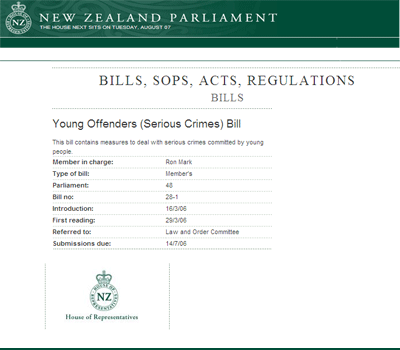
Instead of imprisoning the young, let’s get upset about the death toll amongst them, our very young and defenceless. I can imagine a day where, instead of encircling war memorials for commemorative ceremonials New Zealanders will gather at monuments raised in the memory of the children who have been cruelly murdered in our land. Never mind recounting verses about ‘those that grow old’, these kids never even had the chance to grow up let alone old. Again, this is another form of the grand denial of potential to which we seem to be willing to become accustomed.
In like form to John Howard countering perceived widespread sexual abuse amongst Aboriginal communities in outback Australia and sending in the troops, in Wellington the City Council has put two fulltime security guards into the Newtown Flats to counter youth gangs and perceived widespread crime. Think about this. This means security staff working three shifts seven days a week amounting to something in the order of 8 fulltime staff. What would happen if the Wellington City Council assumed the potential of the community and went into dialogue with the residents? Maybe you would end up with workers directed to an after school homework programme, a sports programme, cultural activities, holiday programmes, people to support the sick and elderly, and so forth. Maybe at night or at certain times a security guard might be necessary but 8 fulltime youth workers and community workers in my experience would resolve the key issues. If there are drug dealers and whatnot at the flats surely with limited points of access in a tower block it wouldn’t take rocket science to catch them. How the Wellington City Council is responding to this situation is symptomatic of how we are responding to these sorts of issues as a nation. We’ll invest heavily in the hammer down and stuff all in the hand up.
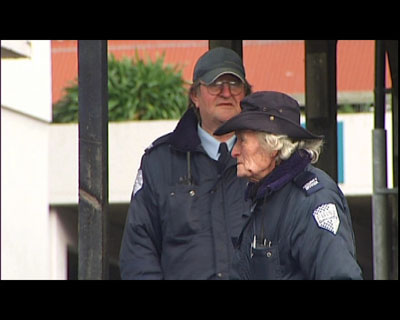
Security guards outside Wellington City Council flats in Newtown.
We’re not on our own. Other cities in other lands face the same issues and pursue the same counter-productive strategies. Brian Sweeney sent me a copy of a New York Times editorial (19 July 2007) headlined “The Wrong Approach to Gangs”. Its brief enough to quote it in its entirety.
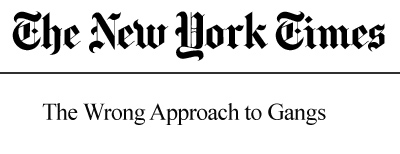
“No city has failed to control its street gangs more spectacularly than Los Angeles. The region has six times as many gangs and double the number of gang members as a quarter-century ago, even after spending countless billions on the problem. But unless Congress changes course quickly, the policies that seem to have made the gang problem worse in Los Angeles could become enshrined as national doctrine in a so-called gang control bill making its way through both the House and Senate.
This issue is underscored in a study released this week by the Justice Policy Institute in Washington. It shows that police dragnets that criminalize whole communities and land large numbers of nonviolent children in jail don’t reduce gang involvement or gang violence. Law enforcement tools need to be used in a targeted way – and directed at the 10 percent or so of gang members who commit violent crimes. The main emphasis needs to be on proven prevention programs that change children’s behavior by getting them involved in community and school-based programs that essentially keep them out of gangs.
Prevention programs have worked extraordinarily well in New York, where street gangs ceased to be a big problem decades ago. But these prevention programs are difficult to sell in Congress, where lawmakers like to show the folks back home how tough they are on crime, even if it means embracing failed policies. By some analyses, the gang control bill circulating in Congress commits nearly 70 percent of the government’s resources to policing and only about a third to prevention.
Proponents of the bill are assuring the rest of us that the statute will be modified to provide more money in support of research-based prevention programs and less for the failed policies of the past. But this bill is shaping up to be a disaster – a policy that would do little about the gang problem where it in fact exists, while filling the jails to bursting with children who would have left the gangs on their own in a year or two. Once jailed, these children will inevitably become hardened criminals and spend the rest of their lives in and out of prison.”
I rest my case.
A few weeks back we had a ‘celebration of life’ party to mark our daughter Kaylene’s return home from hospital. She’s still not 100% but considering that her chances of survival were 0% at one stage it’s a remarkable thing that’s she’s back with her whanau. The nurses and the head of the Intensive Care Unit attended the ‘do’ and we had a chance to thank them and, with Brannigan Kaa’s help, to sing them waiata. Kevin, the head of the ICU gave a short speech in reply. He said that two things were remarkable about Kaylene’s case and unlike anything he had encountered in 20 years of working in the ICU. Firstly, he said, he just did not know what went on when the tohunga intervened, but, belief can have extraordinary results. Secondly, this was the first time in 20 years that any former patient had invited him and his staff to their home to celebrate recovery. Well Doc, you and your staff have our family’s undying respect and admiration. Sing their praises far and wide!
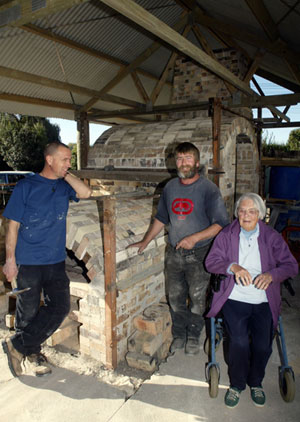
Kiln with Helen, Hooly and John
A month or so back we fired up the new kiln at the Waiohiki Creative Arts Village. The kiln is a work of art in its own right and is a tribute to the creative genius and damned hard work of John Gisborne and Hooly Thin. It’s huge, enabling really large pots or lots of pots to be fired – 530 or so in the first firing. Our matriarch Helen Mason was on hand and after prayers in Maori we blessed the kiln with rice and saki in the Japanese tradition. The Arts Village has been progressing at a pace. We’ve shifted in an old WWII American pre-fab that served as the school hall at Mahora. It now houses our youth development programme. Architect Graham Weaver has prepared our landscape plan and we have working drawings for our second building for artists in residence.
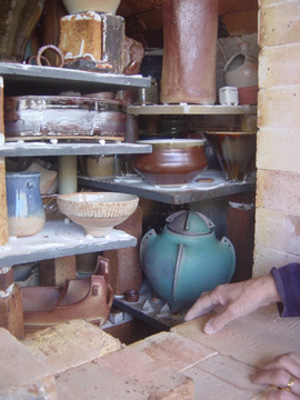
Opening the kiln
It’s a sunny day. The gardens are in good nick but after the prolonged rain and the thrashing the property took during the tangi there are several jobs to do. At Mataariki we planted garlic and shallots, onions and chives and now its time to dig in the mustard so it can enrich the soil for the Maori spuds, Tutaekuri, Moemoe and Pereperu. Tonight the sky will be bright and clear and we will gather around the outside fire and yak into the evening. The week ahead will be full of politics and media and those difficult engagements dissuading people from one path and persuading them to take another. It is relentless and I am starting to feel my years. But, tonight the sky will be clear. Ka whiti mai te ra apopo.
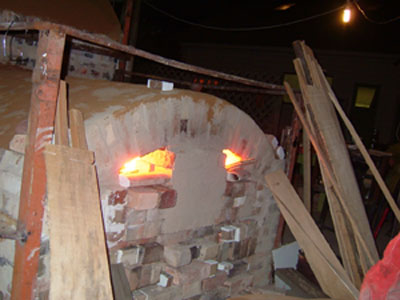
First firing of the kiln, 1 June 2007




















